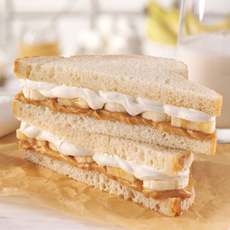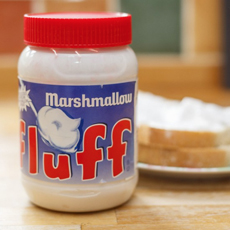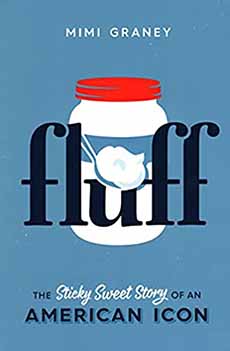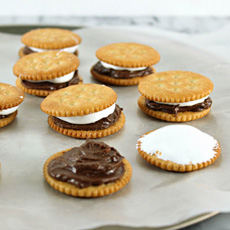Gourmet Fluffernutter & Fluffernutter Cookies For National Fluffernutter Day
|
|
National Fluffernutter Day is October 8th, honoring the classic peanut butter and marshmallow cream sandwich on white bread (photo #1).
The original Marshmallow Fluff was introduced more than 75 years ago and is still made by Durkee-Mower Inc. Some brands call it marshmallow cream, others marshmallow creme. What’s the difference between cream and creme? Just the spelling. Creme is an Americanization of the French word for cream, crème? (pronounced KREHM). Why adapt a French word instead of good old American cream? Most likely adapted to make the dish sound more special. There’s no need to misspell and mispronounce another language’s word for cream. Unless it’s a French recipe, such as Coeur à la Crème, stick to cream. The recipes are below. Marshmallow dates back to ancient Egypt. The marsh mallow plant that was plentiful along the banks of the Nile has a slippery sap that forms a gel when mixed with water. The Egyptians mixed the “juice” with honey to make a confection, reserved for the wealthy and the gods. The Roman scholar Pliny the Elder credited the sap with curing all sorts of diseases, and encouraged people to drink the juice daily, although it wasn’t very palatable (what happened to the honey?). Still, for centuries the sap was used to treat sore throats, skin conditions, and other maladies. In the mid-19th century, a pharmacist in Paris came up with the idea of whipping the sap with sugar and egg whites into a light, sweet, fluffy throat remedy. A variation soon became popular as marshmallow candy. By the late 19th century, confectioners had determined how to mass-produce marshmallows, which included eliminating the sap entirely and replacing it with gelatin. Prepared gelatin was patented in 1845. In addition to setting aspics, it was desirable as glue, a use that also dates back to the marsh mallow plants of ancient Egypt. Prior to 1845, it was laborious to render and clarify gelatin from cattle and pig bones, skin, tendons and ligaments. Marshmallow sauces were popular in the early 20th century (see Marshmallow History). But to make marshmallow sauce or frosting required that the cook first make marshmallow creme. It was a two-step process: make a sugar syrup, melt marshmallow candy in a double boiler, and combine them with the syrup. But, the popularity created an opportunity. In 1910 a marshmallow cream called Marshmallow Fluff was sold to ice cream parlors by Limpert Brothers, a company that still exists in New Jersey. You can see the original packaging here. Call greater Boston the home of marshmallow cream! Today, the Durkee Mower Company sells about 8 million pounds of Fluff each year. In 2021, the Merriam-Webster dictionary added “fluffernutter” to its dictionary: “a sandwich made with peanut butter and marshmallow crème between two slices of white bread.” There’s also a book published in 2017: Fluff: The Sticky Sweet Story Of An American Icon. In Somerville, Massachusetts, there’s an annual ”What The Fluff” festival, where “tens of thousands of people celebrate every possible use of the concoction” [source] There’s that crème again. Here’s why we’re frustrated. Ricemellow Creme, manufactured by Suzanne’s Specialties, Inc., is a vegan equivalent. In 1917, during World War I, Emma Curtis published a recipe for the Liberty Sandwich, which consisted of peanut butter and Snowflake Marshmallow Creme on oat or barley bread. The recipe was published in a promotional booklet sent to Curtis’ customers in 1918, and is believed to be the origin of today’s Fluffernutter sandwich. You can make your own version of Fluff at home, with this recipe. |
|
|
Beyond the original (vanilla), you can make chocolate “Fluff,” gingerbread, etc. You’ll love the flavor from pure vanilla extract, and can make gift batches for Fluff-loving friends and family. |
||
|
RECIPE: FLUFFERNUTTER COOKIES Christine Fischer of Wry Toast created these Fluffernutter cookies and sent them to PB & Co., producers of gourmet peanut butters. Here are step-by-step photos on ILovePeanutButter.com. Prep time is 15 minutes for 15 sandwich cookies. We made substitutions, as noted below, to trade the salty elements (butter crackers, bacon) for sweeter ones (cookies and banana chips). Ingredients For 15 Cookie Sandwiches 1. LINE a medium-size baking sheet with parchment paper. 2. SPREAD a small amount of peanut butter on half of the crackers/cookies, then a small amount of fluff on the other half. Sandwich together, then transfer to baking sheet. Place in the freezer for 30 minutes. 3. COMBINE the chocolate chips and coconut oil in a microwave-safe bowl. Microwave for approximately one minute until melted, stirring at the 30-second mark to avoid burning. 4. REMOVE the frozen sandwiches from the freezer. Dip each halfway in melted chocolate, then return to the baking sheet and sprinkle the bacon on top. Repeat until all sandwiches have been coated and topped, then return to the freezer until the chocolate is set, at least an hour. For The Crackers We tried these, all with very satisfactory results: |
 [7] Fluffernutter cookies topped with bacon from Christine Fischer | Wry Toast Eats.
|
|
|
|
||











